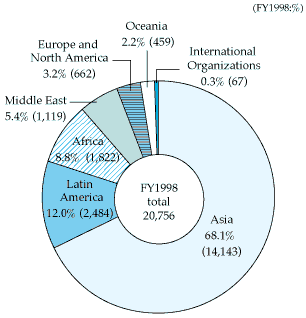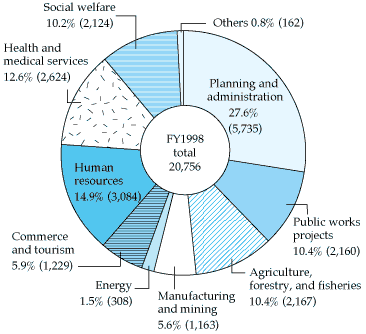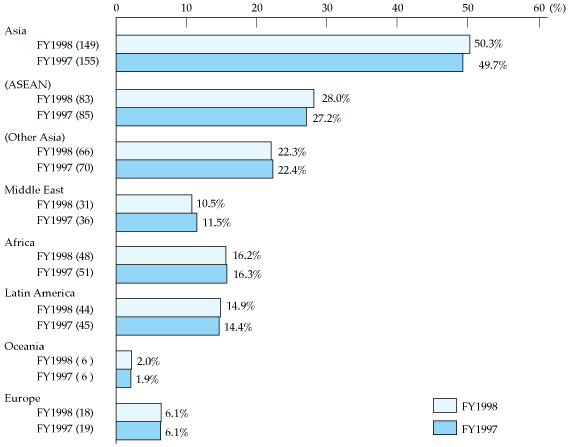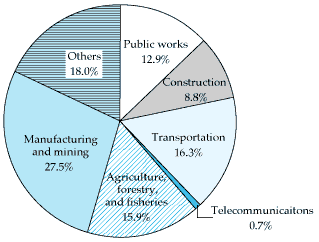Official Development Assistance (ODA)
Chapter 2 Japan's Official Development Assistance in 1998
Section 6 Achievements by Type of Aid
2. State of Implementation of Technical Cooperation
Developing countries' requirements are increasingly diversifying, and expectations of aid from Japan are growing, at a time when "aid fatigue" is taking a toll on aid from other advanced countries. This is the context in which technical cooperation in FY1998 reached ¥362.7 billion, of which JICA channeled ¥155.8 billion to technical cooperation aid.
JICA's technical cooperation in FY1998 analyzed by region is as follows: Asia accounted for 43.2 percent, Latin America for 20.7 percent, Africa for 14.4 percent, the Middle East for 8.0 percent, Oceania for 2.7 percent, and Europe, etc., for 5.2 percent, while international agencies received 0.7 percent. Asia's share of technical cooperation was the largest (the calculation excludes regionally unclassifiable spending), the same scale as Japan's ODA as a whole.
In Asia, East and Southeast Asia suffered from the economic crisis triggered by the collapse of the Thai baht; Southwest Asia is beginning to introduce market principles and is actively promoting development policies that emphasize keeping a macroeconomic balance. JICA's technical cooperation in Asia was composed of accepting 14,143 trainees (68.1 percent of all trainees coming to Japan from all parts of the world, 7,929 more than in the previous year. Large scale in-country training was implemented in response to the Asian economic crisis.), dispatching 2,856 experts (53.8 percent of the total, up 104 from the previous year), sending 4,167 officials and consultants on study missions (47.6 percent, down 174), and assigning 913 JOCV team members (26.2 percent of the world total, down 40).
In the Middle East, Japan's cooperation has two priorities in common throughout the region, due to the political, economic, and social diversity: concern for the environment and effective use of resources (water, tourism, etc.). JICA's technical cooperation in this region was composed of 1,119 trainees taught in training programs (5.4 percent, 73 more than in the previous year), 410 experts sent overseas (7.7 percent, down 1), 762 officials and consultants sent on study missions (8.7 percent, down 191), and 185 JOCV team members on overseas assignments (5.3 percent, up 11).
Cooperation extended to Africa through JICA varies, given the continent's individuality and diversity, but all cooperation addresses common priorities like basic education, health and medical care, water resource development, agricultural development, living standard improvement, economic infrastructure construction, and environmental protection. JICA has enrolled 1,822 Africans in training programs (8.8 percent, up 222), sent 422 experts to Africa on missions (8.3 percent, down 26), sent 1,246 officials and representatives there on study missions (14.2 percent, down 276), and stationed 870 JOCV team members (25.0 percent, down 81).
Development studies were carried out on 296 cooperation projects, compared to 312 in FY1997.
Furthermore, in the interest of improving aid efficiency, project confirmation missions were sent to about 30 countries and 50 project formulation missions were sent. About 60 project planning advisors were dispatched.
Development-related fiscal investment and lending totaled ¥354.4 million in loan commitments to development cooperation projects, through which the Pilot Project for Cultivation of hime-matsutake mushrooms in Paraguay and the Experimental Project for the Cultivation of Sugarcane in the Philippines were financed.
3. State of Implementation of International Disaster Relief
In the period from April 1998 to September 1999, Japan has provided disaster relief of the following types (financial aid is covered in Emergency Grant Aid (1. (4) above).
(1) Dispatch of Japan Disaster Relief Teams
A string of major natural disasters occurred around the world over 1998-99, including floods in China and Bangladesh, two hurricanes in the Caribbean and Central America, and earthquakes in Colombia, Turkey, and Taiwan. The earthquakes in Turkey in August and in Taiwan in September were particularly severe, leaving even more victims than Japan's Great Hanshin-Awaji Earthquake.
Japan responded to these disasters by dispatching 15 disaster relief teams (a total of 514 personnel) over the last year (April 1998-September 1999). These comprised three rescue teams (186 personnel), seven medical teams (91 personnel), four teams of experts (32 personnel), and one Self Defense Forces (SDF) unit (205 personnel).
The three rescue teams were deployed to Colombia (January 1999) and Turkey (August 1999), and Taiwan (September 1999) in response to the large-scale earthquakes which struck these countries. These were extremely quick responses, with teams arriving at the site of the disasters within 48 hours after they struck. In Turkey the rescue team achieved its first success at rescuing a survivor since the inception of Japan Disaster Relief Team.
Medical teams also attended these disasters in Colombia, Turkey and Taiwan), as well as flying into Papua New Guinea (July 1998), where an earthquake-induced tsunami caused numerous fatalities. They were also on the scene in the Dominican Republic in October and in Nicaragua in November, dealing with the massive hurricane damage sustained in these areas. The medical teams operated with great flexibility, not only treating external wounds in the wake of disaster, but also responding sensitively to the way in which medical needs changed as time went on, providing internal and pediatric care and handling infectious diseases.
The expert team of public health deployed after the floods in Bangladesh in October 1998, as well as the team of earthquake-proofing experts sent out after the earthquakes in Turkey and Taiwan, provided advice and guidance in emergency post-disaster restoration in line with their particular areas of knowledge, earning the high commendation of the recipient governments.
When Honduras was struck by a hurricane of historical scale in November 1998, its government's appeal for assistance resulted in the first ever deployment of an SDF unit in accordance with the Law Concerning the Dispatch of Japan Disaster Relief Teams. The SDF unit and additional personnel made up a 205-member disaster relief team which worked successfully to provide medical care and epidemic control in Honduras. Moreover, after the earthquake in Turkey , three Maritime Self Defense Force vessels, including the "Bungo", were dispatched under the same law to transport 500 prefab houses donated by Hyogo Prefecture to victims of the disaster who had lost their homes.
Chart 66 Recent Disaster Relief Efforts (April 1998 through September 1999)
| Disaster | Date Aid Was Determined | Japan Disaster Relief Team | Supplies Provided | ||
|---|---|---|---|---|---|
| Flooding in Uruguay | 14 May, 1998 | Tents, generators, cords and reels | |||
| Total aid provided | ¥9,223,000 | ||||
| Flooding in Argentina | 15 May, 1998 | Tents, sleeping mats and other supplies | |||
| Total aid provided | ¥15,122,000 | ||||
| Drought in Guyana | 25 May, 1998 | Simple water tanks (2,000L and 3,000L) | |||
| Total aid provided | ¥8,118,000 | ||||
| Earthquake in Bolivia | 25 May, 1998 | Tents, blankets, water purifiers, and medicines | |||
| Total aid provided | ¥9,980,000 | ||||
| Flooding in Sakha (Russian Federation) |
10 Jun., 1998 | Blankets,torches and dry battery cells | |||
| Total aid provided | ¥20,160,000 | ||||
| Drought in Nepal | 22 Jun., 1998 | Blankets,medicines and medical supplies | |||
| Total aid provided | ¥9,548,000 | ||||
| Flooding in Romania | 1 Jul., 1998 | Tents, medicines, medical and other supplies | |||
| Total aid provided | ¥11,916,000 | ||||
| Flooding in China | 3 Jul., 1998 | Water purifiers , medicines, medical and other supplies | |||
| Total aid provided | ¥29,516,000 | ||||
| Tsunami in Papua New Guinea | 21 Jul., 1998 | Medical team (11 members) July 21-August 3 |
|||
| Total cost for team | ¥71,160,000 | ||||
| 23 Jul., 1998 | Tents, carpentry sets, plastic sheets and other supplies | ||||
| Total aid provided | ¥39,590,000 | ||||
| Flooding in China | 7 Aug., 1998 | Water purifiers, generators and tents | |||
| Total aid provided | ¥49,412,000 | ||||
| Flooding in Bangladesh | 26 Aug., 1998 | Medicines, medical supplies, water purifying agents and other supplies | |||
| Total aid provided | ¥29,909,000 | ||||
| Flooding in Mexico | 11 Sep., 1998 | Blankets, generators, oil cookers and other supplies | |||
| Total aid provided | ¥14,986,000 | ||||
| Flooding in Sudan | 22 Sep., 1998 | Tents, blankets, plastic sheets | |||
| Total aid provided | ¥18,243,000 | ||||
| Hurricane in Cuba | 29 Sep., 1998 | Water purifiers, towels, soap and other supplies | |||
| Total aid provided | ¥15,976,000 | ||||
| Hurricane in Dominican Republic | 29 Sep., 1998 | Blankets, medicines, medical supplies | |||
| Total aid provided | ¥16,127,000 | ||||
| Hurricane in Haiti | 29 Sep., 1998 | Tents, generators, water purifiers and other supplies | |||
| Total aid provided | ¥19,977,000 | ||||
| Hurricane in Saint Christopher and Nevis | 29 Sep., 1998 | Blankets, Tents | |||
| Total aid provided | ¥6,979,000 | ||||
| Hurricane in Antigua Barbuda | 29 Sep., 1998 | Blankets, Tents, sleeping mats and other supplies | |||
| Total aid provided | ¥7,848,000 | ||||
| Flooding in China | 29 Sep., 1998 (Transport of private relief supplies) |
Relief supplies received: blankets | |||
| Amount supplied | ¥43,739,000 | ||||
| Flooding in Bangladesh | 1 Oct., 1998 | Expert Team (7 members) October 2-October 15 |
Water purifying, infusion solution, orally administered replacement fluid, antipyretics and other supplies | ||
| Total cost for team | ¥23,694,000 | Total aid provided | ¥29,657,000 | ||
| Hurricane in Dominican Republic | 6 Oct., 1998 | Medical Team (5 members) October 8-October 21 |
|||
| Total cost for team | ¥25,054,000 | ||||
| Forest Fire in Sakhalin (Russian Federation) |
7 Oct., 1998 | Blankets, sheets, pillows | |||
| Total aid provided | ¥5,010,000 | ||||
| Pipeline burst in Nigeria | 21 Oct., 1998 | Medicines, medical supplies | |||
| Total aid provided | ¥3,190,000 | ||||
| Hurricane in Honduras | 2 Nov., 1998 | Simple water tanks, generators, water purifiers, and other supplies | |||
| Total aid provided | ¥15,958,000 | ||||
| 13 Nov., 1998 | Self-Defense Forces team (205 members) November 13-December 9 |
||||
| Total cost of dispatch (JICA share) | ¥227,987,000 | ||||
| Hurricane in Nicaragua | 2 Nov., 1998 | Blankets, sleeping mats, soap | |||
| Total aid provided | ¥19,891,000 | ||||
| Hurricane in El Salbador | 5 Nov., 1998 | Tents, medicines and medical supplies | |||
| Total aid provided | ¥11,973,000 | ||||
| Hurricane in Guatemala | 5 Nov., 1998 | Tents, generators, water purifiers and other supplies | |||
| Total aid provided | ¥12,284,000 | ||||
| Hurricane in Nicaragua | 10 Nov., 1998 | Medical team (16 members) November 12-November 25 |
|||
| Total cost for team | ¥58,943,000 | ||||
| Flooding in Ukraine | 24 Nov., 1998 | Tents, blankets, medicines and medical supplies | |||
| Total aid provided | ¥13,918,000 | ||||
| Earthquake in China | 24 Nov., 1998 | Tents, blankets, sleeping mats | |||
| Total aid provided | ¥17,655,000 | ||||
| Earthquake in Colombia | 26 Jan., 1999 | Rescue team (37 members) January 26-February 4 |
|||
| Total cost for team | ¥124,943,000 | ||||
| 27 Jan., 1999 | Medical team (15 members) January 28-February 10 |
Tents, blankets, simple water tanks, generators, and other supplies | |||
| Total cost for team | ¥49,693,000 | Total aid provided | ¥25,654,000 | ||
| Flooding in Mozanbique | 10 Mar., 1999 | Tents, blankets plastic sheets and other supplies | |||
| Total aid provided | ¥15,000,000 | ||||
| Cyclone in Pakistan | 27 May, 1999 | Blankets, oil cookers, medicines and medical supplies | |||
| Total aid provided | ¥17,970,000 | ||||
| Flooding in Peru | 28 May, 1999 | Tents | |||
| Total aid provided | ¥14,876,000 | ||||
| Cholea in Madagascar | 28 May, 1999 | Vaporizers, masks, gloves, disinfectant | |||
| Total aid provided | ¥3,092,000 | ||||
| Earthquake in Turkey | 17 Aug., 1999 | Rescue team (39 members) August 17-August 24 (1st) August 18-August 24 (2nd) |
|||
| Total cost for team | ¥110,431,000 | ||||
| 17 Aug., 1999 | First Medical team (16 members) August 18-August 31 |
||||
| Total cost for team | ¥57,750,000 | ||||
| 18 Aug., 1999 | Tents, blankets, sleeping mats, plastic sheets, simple water tanks, generators, and other supplies | ||||
| Total aid provided | ¥47,805,000 | ||||
| 20 Aug., 1999 | Expert team (8 members) August 22-August 28 |
||||
| Total cost for team | ¥14,321,000 | ||||
| 26 Aug., 1999 | Second Medical team (15 members) | ||||
| Total cost for team | ¥55,115,000 | ||||
| 26 Aug., 1999 | Generators, cords and reels, sleeping mats, simple water tanks, polyethylene tanks, blankets, carpentry sets | ||||
| Total aid provided | ¥119,673,000 | ||||
| 9 Sep., 1999 | Expert team (11 members) October 12-November 1 (forward team, 3 members) October 19-November 9 (later team, 8 members) |
||||
| Total cost for team | ¥20,882,000 | ||||
| Transportation of prefab housing by Maritime Self Defense vessel | |||||
| Total cost of transport | ¥135,106,000 | ||||
| Tornado in South Africa | 7 Sep., 1999 | Tents, blankets, sleeping mats, and other supplies | |||
| Total aid provided | ¥11,996,000 | ||||
| Earthquake in Greece | 26 Aug., 1999 | Tents, blankets | |||
| Total aid provided | ¥14,180,000 | ||||
| Earthquake in Taiwan | 21 Sep., 1999 | Rescue team (110 members) September 21-28 (1st and 2nd) September 22-28 (3rd) |
|||
| Total cost for team | ¥113,574,000 | ||||
| Medical team (13 members) September 22- October 5 |
|||||
| Total cost for team | ¥38,490,000 | ||||
| Expert team (6 members) September 27- October 1 |
Tents, generators, cords and reels and other supplies | ||||
| Total cost for team | ¥5,582,000 | Total aid provided | ¥29,800,000 | ||
| Hurricane in Bahama | 30 Sep., 1999 | Generators , cords and reels, carpentry sets, sleeping mats | |||
| Total aid provided | ¥9,494,000 | ||||
(2) Provision of emergency supplies
The provision of emergency supplies was carried out 30 times in FY1998, a record level on an annual base (in FY1999, as of September, such provisions have been made nine times). In one of these cases, after heavy rain around China from the middle of June 1998 caused the most devastating floods the country had ever experienced, Japan made three deliveries of emergency supplies. The third instance saw collaboration between the government and the people of Japan, with local communities, NGOs and other groups donating around 10,000 blankets and the government shouldering the freight costs for these private relief supplies.




